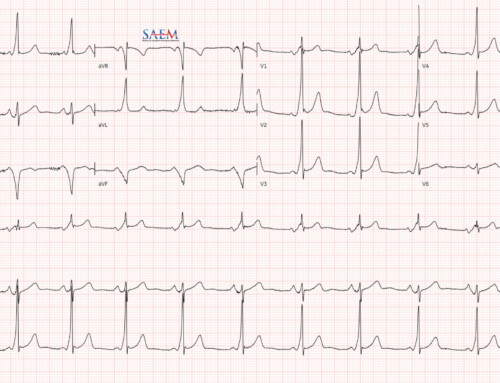We are proud to present Capsules Module 8: Venous Thromboembolism, now published on ALiEMU. Here is a summary of the key points from this outstanding module by Drs. Jill Logan and Doug Gowen.
Go to ALiEMU module
Summary: Venous Thromboembolism
Venous thromboembolisms (VTE) constitute disease states with a wide array of presentations ranging from incidental findings to imminent mortal peril. Treatment of these disease states necessitates a comprehensive understanding of the delicate balance of the pro-coagulant and anti-coagulant forces within the body and their means of manipulation through pharmacologic intervention. This Capsule will assist the reader in their understanding and application of current therapeutic interventions for VTE as well as invite the reader to explore the evidence behind these recommendations. This preview highlights a few Capsules in this module.
Oral Anticoagulation for VTE
Warfarin has traditionally been the best (and only) available oral anticoagulant in our arsenal, however, a substantial practice shift has occurred with numerous direct oral anticoagulants (DOAC) now available. These DOACs have been approved to treat both deep vein thromboses (DVTs) as well as pulmonary embolisms (PE) and may now be considered first-line in patients without cancer.
Warfarin is notorious for drug-drug interactions but care should still be used with the DOACs when combined with p-glycoprotein inhibitors and inducers.
Parenteral Anticoagulation for VTE
At times, parenteral anticoagulation may be indicated over oral therapy. For example, low molecular weight heparins (LMWHs) remain the drug of choice for patients with VTE and active cancer. Additionally, when using warfarin, bridge therapy is recommended for a minimum of five days to assure adequate anticoagulation while achieving a therapeutic INR. Heparin therapy offers an advantage in patients who are unstable or in whom surgical intervention may become necessary due it’s relatively short duration of action and ability to be reversed with protamine.
Some DOAC agents necessitate treatment with parenteral anticoagulation for 5 days prior to initiation for VTE.
VTE in Pregnancy
Pregnancy is a hypercoagulable state and the risk of VTE increases as gestation progresses. LMWHs are the treatment of choice in pregnancy, however, therapeutic doses of subcutaneous heparin may also be an option. The DOAC agents have not been tested in pregnancy and due to unknown effects on the fetus, their use is not recommended.
Warfarin may be teratogenic and should not be used in pregnancy.
VTE in Pediatrics
LMWHs have become the agent of choice for the treatment of VTE in children, however, there is very little published clinical data to support one therapy over another. Unlike adult patients receiving LMWHs, therapeutic drug monitoring is recommended for all pediatric VTE patients receiving this therapy.
Use extreme caution when prescribing anticoagulation in pediatrics to avoid dosing errors due to concentration differences among anticoagulants.
Breakthrough Clotting
From time to time, the ED provider may be presented with a patient on therapeutic anticoagulation presenting with a new clot or clot worsening. After assessment of compliance and investigation of potential drug-drug interactions to ensure therapeutic anticoagulation has been maintained, therapy may be switched to LMWH therapy. If the patient was already receiving LMWH, a temporary dose increase by approximately 25% may be considered.
Many of the DOAC agents have different dose recommendations based on indication. Ensure patients with breakthrough clots were prescribed the correct DOAC dose before considering the therapy a failure.
Hemodynamically Unstable PE Management
Thrombolytic therapy may be considered for massive PE and some select submassive PE patients. Alteplase is approved for use in massive PE as a 2 hour infusion of 100 mg. Patient acuity may necessitate more rapid intervention and administration of thrombolytic via intravenous push has been suggested. Alternatively, some evidence suggests that lower thrombolytic doses may be appropriate in submassive PE patients.
Resuscitation efforts are recommended to continue for 15-20 minutes following thrombolytic administration in cardiac arrest situations.
Course Contributors
| Role | Team Member | Background |
| Authors | Jill Logan, PharmD, BCPS @EMPharm | EM Pharmacist, University of Maryland Medical Center |
| Doug Gowen, PharmD, BCPS @DougEDPharm | EM Pharmacist, Glens Falls Hospital | |
| PharmD Reviewers | Michelle Hines, PharmD, BCPS @mEDPharmD | EM Pharmacist, University of Maryland Medical Center |
| Paul Takamoto, PharmD @ptakpharm | EM Pharmacist, University of California San Francisco | |
| Associate Editor | Craig Cocchio, PharmD, BCPS @iEMPharmD | EM Pharmacist, Trinity Mother Frances Hospital |
| Physician Reviewer | David Juurlink, BPharm, MD, PhD, FRCPC @DavidJuurlink | Professor of Medicine, University of Toronto |
| Copy Editor | Meghan Groth, PharmD, BCPS @EMPharmgirl | EM Pharmacist, UMass Memorial Medical Center |
| Creator and Lead Editor | Bryan Hayes, PharmD, FAACT, FASHP @pharmertoxguy | EM Pharmacist, Massachusetts General Hospital; Assistant Professor of EM, Harvard Medical School |




